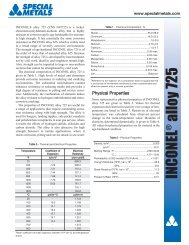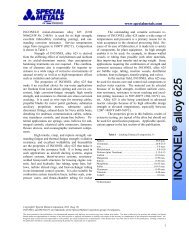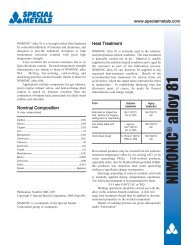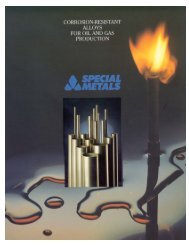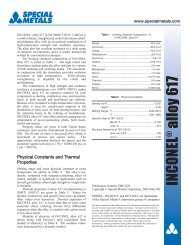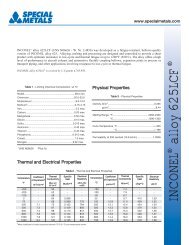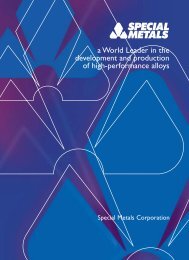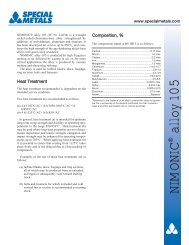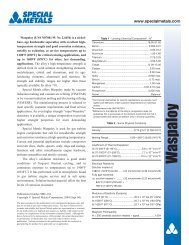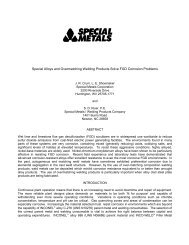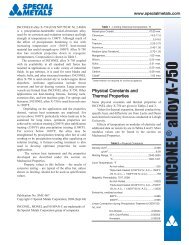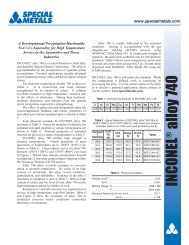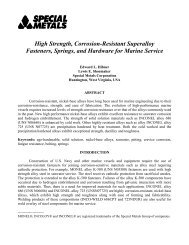Material Safety Data Sheet - Special Metals Corporation
Material Safety Data Sheet - Special Metals Corporation
Material Safety Data Sheet - Special Metals Corporation
Create successful ePaper yourself
Turn your PDF publications into a flip-book with our unique Google optimized e-Paper software.
<strong>Special</strong> <strong>Metals</strong> <strong>Corporation</strong> <strong>Material</strong> <strong>Safety</strong> <strong>Data</strong> <strong>Sheet</strong>APPENDIX 2TOXICOLOGICAL AND EXPOSURE LIMIT INFORMATIONThe following information is primarily directed to the ingredients of the complex alloys listed in APPENDIX 1. Although itis the user's responsibility to assess end products, intermediates or fugitive emissions arising out of the use of these alloys,information is also provided for common fume ingredients. UK EH40 limits for the ingredients are shown in italics at the endof each section.Aluminum (Al)Exposure Limits (1) :TLV: 10 mg/m 3 (Metal dust); 5 mg/m 3 (Welding fumes)PEL: 15 mg/m 3 (Total metal dust); 5 mg/m 3 (Metal dust - respirable fraction)CAS No. (2) : 7429-90-5LD 50 : Not AvailableAluminum is not readily absorbed through the skin or the GI tract and only poorly through the lungs. Foreign literaturebetween 1958 and 1962 reported cases of severe and sometimes fatal pulmonary fibrosis in workers exposed to aluminumdust. In one of the fatal cases, the worker developed fibrosis and encephalopathy after 13.5 years of exposure to aluminumdust.In rodent studies and currently in US industry, no fibrosis or encephalopathy have been reported from the inhalation ofaluminum powder. Acute exposure to alumina fume may cause bronchial irritation, however reports of pulmonary fibrosisand emphysema in alumina abrasive workers are no longer seen, owing to improved environmental control.EH40 - Aluminium metal:Total inhalable dust OES 10 mg/m 3 (8 hours TWA)Total respirable dust OES 4 mg/m 3 (8 hours TWA)Chromium (Cr)Exposure Limits (1) : TLV: 0.5 mg/m 3PEL: 1.0 mg/m 3 (Metal as Cr); 1 ug/m 3 (8 hours TWA) (Chromium VI compounds)CAS No. (2) : 7440-47-3LD 50 : Not AvailableChromium metal is relatively nontoxic. Chromium metal and insoluble salts are said to be involved in fibrosis of the lungs.When the metal is heated to a high temperature, fumes produced may be damaging to the lungs if inhaled. The InternationalAgency for Research on Cancer has concluded that the evidence for carcinogenicity in humans and animals is inadequate forchromium metal and trivalent chromium compounds, but sufficient for hexavalent chromium compounds. Fumes fromwelding chromium-containing stainless steel or certain chromium-containing rods can trigger eczematous eruptions on thepalms of the hands of chromium-sensitized individuals.EH40 - Chromium:Chromium VI compounds (as Chrome) MEL 0.05 mg/m 3 (8 hours TWA)Chromium II compounds (as Chrome) OES 0.5 mg/m 3 (8 hours TWA)Chromium III compounds (as Chrome) OES 0.5 mg/m 3 (8 hours TWA)Chromium OES 0.5 mg/m 3 (8 hours TWA)Cobalt (Co)Exposure Limits (1) :TLV: 0.02 mg/m 3 (Dust & fume as Co)PEL: 0.1 mg/m 3 (As Co metal)CAS No. (2) : 7440-48-4LD 50 : 6,170 mg/kg, rat, oralAsthmatic symptoms and pulmonary fibrosis occurring in the tungsten carbide industry may be related to the inhalation ofmetallic cobalt dust. Evidence of polycythemia (an increase in the total red cell mass of the blood in the body) and alteredthyroid, kidney and liver function have also been found. Excessive inhalation of metallic cobalt have produced cardiacchanges in miniature swine. Eye contact may cause conjunctivitis. Symptoms of excessive ingestion may be a sensation ofhotness with vomiting, diarrhea and nausea along with the potential for causing damage to blood, heart, thyroid and pancreas.Repeated skin contact can cause sensitivity and allergic skin rashes. Cobalt powders have caused tumors at the site of injectionin rodents. However, studies of cobalt-containing prostheses do not suggest a significant risk for humans.EH40 - MEL 0.1 mg/m 3 (8 hours TWA)11



